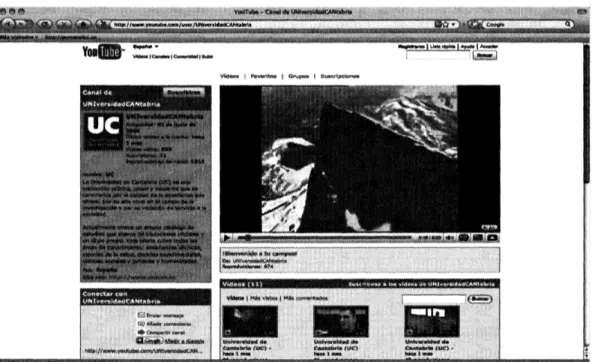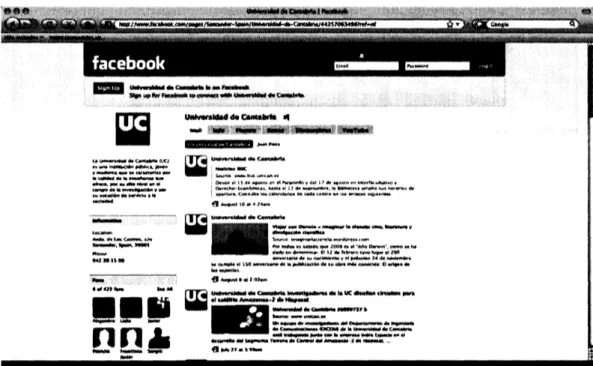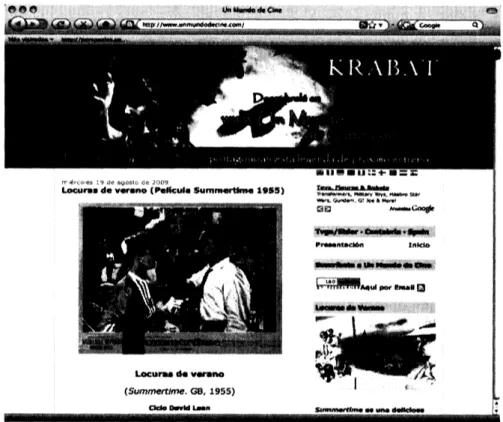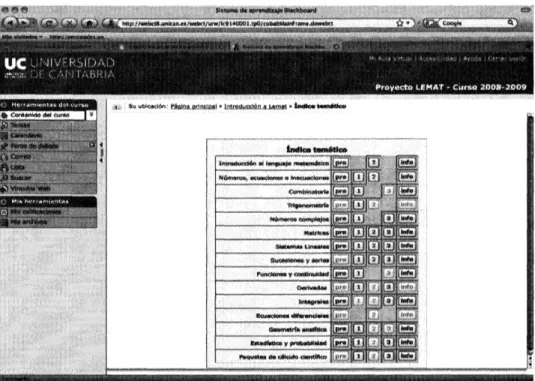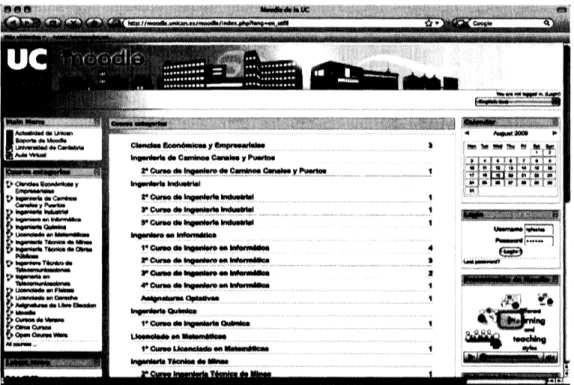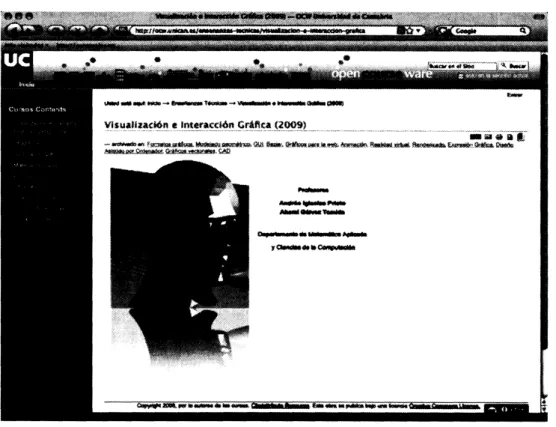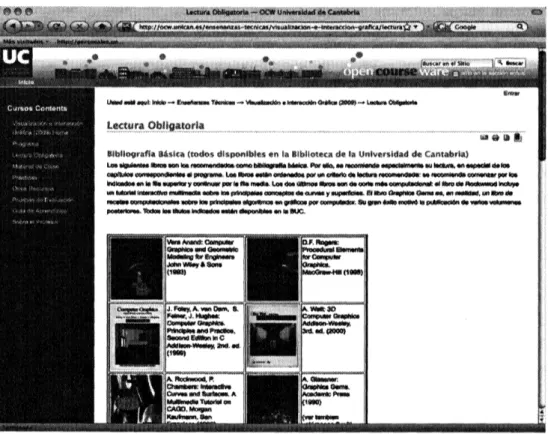Computer Technologies for XXI Century
Education:
A
New Way
to Communicate
and
Learn
at
the University
of Cantabria
Andr\’es
Iglesias
Department
of
Applied Mathematics and
Comp.
Sciences
University
of
Cantabria,
Avda. de los
Castros
s/n,
E-39005, Santander, Spain
iglesias@unican.es
http://personales.unican.es/iglesias
Abstract
Academic institutions of most Europeancountries are nowundertaking the final
steps of the overall process of convergence for university and college studies, the
so-called European Space
of
Higher Education (ESHE). This process, born fromBologna‘s declaration, implies a dramatic change in our way of teaching and
learn-ing. It also demands a bulk of computer teclmologies to be used at full extent
in order to fulfill Bologna’s declaration needs and requirements. The author has
been strongly involved during thelast few years in the process of adaptation ofhis
institution, the University ofCantabria,to ESHE. As aresult, thepresent paper is
aimed at sharing his experiences in this challenging task, by exploring how to use
efficiently the wealth of computer technologies available from the perspective of a
university teacher, department chair and postgraduate studies coordinator.
1
Introduction
Nowadays students, teachers, administrators and authorities of most European
Universi-ties and Colleges arefacingonethe most important educationalchanges in recenthistory:
the European Space
of
Higher Education (ESHE). This term summarizes an ambitiousinitiative of many European countries to adapt their Higher Education systems and
reg-ulations to a standard system, initially stated in Bologna’s Declaration back in 1999. The target is to create $a$ European space
for
higher education in order to enhance theemployability and mobility
of
citizens and to increase the international competitivenessof
European higher education [1]. The ultimate goal is to ensure that the European higher education system acquires a worldwide degreeof
attractiveness equal to [Europe’s]ex-traordinary cultural and
scientific
traditions [1]. To this purpose, all signatory countriesmust reform their
own
higher education systems in order to create overall convergence at European level. Some major objectives of this approachare:
$\bullet$ the adoption of a common framework of readable and comparable $degre\epsilon\approx$,
$\bullet$ the introduction of undergraduate and postgraduate levels in all countries along
with ECTS (European Credit Transfer System) credit systems to
ensure
a smoothtransition from
one
country)$s$ system to anotherone
and$\bullet$ the promotion of free mobility of students, teachers and administrators among the European countries.
This process, bom from Bologna’s declaration, implies a dramatic change in our way of teaching and learning. European countries
are
now
undertaking the final steps of theprocess of restructuring their higher education system in order to attain the objectives ofthe declaration. At this time, the developments focus especially
on
academic aspects,such
as
the definition of the new curricula and grading systems. However, the upcoming changes go far beyond these structural changes,as
the personal development of students and teachers is also at the root of this new concept of education [2]. For instance,students in this
new
modelare no
longer passive actors of the leaming process.On
thecontrary, Bologna’s declaration emphasizes the concept of self-learning
so
that studentsare
gettingmore
andmore
involved in their own leaming. An important issue in thisprocess is to provide students with a good collection of supporting scholar materials and technologies that enable them to accomplish the learning process by themselves [4, 5]. On the other hand, such technologies
are
also needed for teachers for (among others)mentoring, assessment, advisory and monitoring tasks.
The author has been strongly involved during the $la\backslash st$ few years in the process of
adaptation of his institution, the University of Cantabria, to ESHE. During the last five
years, he has been in charge ofa number of issues, including:
$\bullet$ postgraduate (Master and Ph.D.) studies,
as
the Ph.D. studies coordinator of his department firstly and then alsoas
a
member of the University Council for ESHE Postgraduate studies,$\bullet$ graduate studies
as
a University teacher and alsoas
a member of the councils of both the Faculty of Sciences and the Industrial Engineering School, and finally $\bullet$ as a University administrator because of his positionas a
department chair atthe Department of Applied Mathematics and Computational Sciences, the largest
department at the University of Cantabria.
Duringthis five years span,theUniversity ofCantabria has also triggered
an
ambitiousprojecttowards the intensiveuseoftechnology inall
areas
oftheeducational, research andmanagementprocesses. Thecoreof this project isthe development ofanubiquitous,
fully-integrated, anytime-anyone available computer system to handle all aspects ofstudents and teachers daily work in a smoothly way, with the ability to communicate with all electronic (either wired or wireless) devices and systems that are commonly available for today’s students and teachers, such
as
laptops, desktop computers and mainframes, PDAs, mobile phones, multiinedia tools atid devices, ATMs, chip-integrated smart cards,GPS systems, car navigators, Internet and Intranet communication systems and
so on.
This development also encompasses the adoption of educational supporting programs and systems, such
as
WebCT, Blackboardor
Moodle, open-source software for operatingFigure 1: $r1^{\urcorner}oday$’s student’s “basic“ equipment.
systems (Linux), scientific computing (Scilab and others), multilingual multiplatform
office suites (Open Office and the like), graphical modelers (Blender) and libraries (Open GL), scientific typesetting (LaTeX), programming languages (Java, Python, Ruby, Lua),
integrated development environments for coding and programming (Eclipse, NetBeans), semantic web (RDF, OWL), webservices (DAML$+$OIL),web syndication (RSS), markup
languages (XML), etc. that will be described in detail later
on.
It $ha_{\wedge}s$ been
an
exhausting but also exciting and challenging project. Most of its goals have already been achieved, butwe
are
still workingon
the adoption of new programs,standards and systems. Similarly, new versions and functionalities
are
always required inour
never-ending computer-based environment. However, the project has currentlyreached a level of development good enough for a huge number of tasks and activities. The $\subset\dot{\Re}m$ of this paper is to share this experience with our readers by exploring how to
use
efficiently the wealth of computer technologies available from the perspective ofa
university teacher, department chair and postgraduate studies coordinator.
The structure of this paper is
as
follows: firstly, we givesome
hints about our currentstudents’ profile in Section 2. Then, author’s institution, the University of Cantabria, is briefly portrayed in Section 3. The
core
of the paper is in Section 4, where computer technologies applied to achieved our educational goalsare
carefully described. Finally, main conclusions andsome
further remarks close the paper.2
Our
Students
Today’s students
are
quite different to those of previous decades. In general, theyare
less skilled than their counterparts in the last decades in deduction, mathematical intuition and scientific reasoning and encountermore
problems in solving questions with scientificcontent. Their background is also less solid in both science and arts. Furthermore, they
also have less oral and written communication skills, with a much limited vocabulary
and hence find
some
troubles fora
full comprehension ofconcepts and ideas. Very often,they lack discipline and exhibit poor study habits such
as
poor notetaking skills, poortime management, last minute work. procrastination, over-reliance on classmates and/or
Internet and so on.
So far, the cons; let’s now go to the pross. On the positive side, most current students
come
to college and university with greater computer proficiency and technology skillsthan their predecessors. Technology is natural to them as they got accustomed to
use
it from their childhood. Today’s students’ equipment is by far the most complete and varied we have
ever
seen.
Their basic “machinery” (see Figure 1) comprises modernconnectivity devices such
as
last generation mobile phones (with Bluetooth, camera, Internet connection, GPS, audio and video players andso
on),a
laptop, USB memorycards, webcam, MP3 player, memory sticks, digital
camera
and smart cards. Very often theyhave Internet
connection at horne,a
desktop computer, videogame consoles, wideflat screens, videotape players and recorders, cable and/or satellite TV, and videocamera.
Some students also have GPS, beam proyector, Blue-ray player/recorder, car navigator and other sophisticated electronic devices. They are familiar with terms such
as
pixel,texturing, RGB color palette, and technologies such as remote control, Intemet surfing,
DVI and HDMI connectors and many
more.
Much better, theyare
not only accustomed to technology but also they know how touse
it efficiently. Therefore, properuse
ofcomputer tools and other technology tums out to be
more
than appropriate to promotetheir background to an upper level [4, 5].
3
A Case Study: The University of Cantabria
The University
of
Cantabria (UC onwards) is a young (founded in 1972), medium-size(14000 students, 1097 teachers, 516 staff members), modern public institution whose
main purpose is to contribute to social progress through a firm commitment to teaching
and scientific excellence (see [7] for details). In order to achieve its goals, it strives to constantly improve the quality of its work through a process that revises and improves its teaching, research and administrative activities. The application of this process has
made the UC outstanding among Spamish universities due to its quality and scientific
productivity (among top 10 universities in Spain in both teaching and research).
The University of Cantabria provides students with a wide variety of resources,
en-abling them to acquire a well-rounded education, with pervasive
access
tonew
tecIinolo-gies. Classrooms and laboratoriesare
fitted with advanced equipment to further theprogTess of knowledge. These infrastructures
are
supported bya
computer networkde-signed to include the latest technologies. Students have an electronic card that provides
access
to campus buildings, library, shops, dormitories, dinning halls, sports courts andfacilities and ATM machines along with integrated financial-academic services. Options
of this smart card include checking personal bank account balance, academic grades, building access, password configuration, internet services, laptop loan and many others.
Students also have an e-mail account at their disposal, and can therefore gain electronic
access
to details of their academic record through the “Virtual Campus“, keep in touch with their lecturers or fellow students, or publish theirown
personal pages. Similarly,$\Psi L_{\sim}^{-}\sim’\sim\vee$ $-$ $:_{1,1}$ $1$ $\xi|$ $^{1}r$ $R$ $::^{J*}$ $v$’
.
$lt\backslash \backslash --\backslash ,R\backslash \cdot.\underline{r}\backslash 4^{-}\backslash \vee^{\wedge^{\backslash }}\backslash -..-\cdot\cdot$.. $-$
$\sim$. . :. .$\overline{1}^{\veerightarrow}:$
$\overline{\backslash }_{4}P\tau A-\dot{c}_{-}\sim$
$\backslash \vee\sim\vee-\vee^{-a}$
$\backslash \sim\not\in--\cdot\searrow$
Figure 2: Screenshot of UC $You^{\Gamma}l^{7}ube$ channel.
the UC library provides students and lecturers with documentary resources at nine sites
in the University with 2150
access
points. The library holds 406000 monographic worksand individual volume titles, 9247 periodicals, 10000 publications with electronic
access
and 432 databases and information
sources.
4
What Kind of
Tools and
Methods?
4.1
Communication
Channels
As several reports haveevidenced, communication is averyimportant issueregarding the
educational process. In short, the better the communication channels, the
more
effectivethe learning process. Most of technology in
use
at the UC is intended to improvecom-munication between students and teachers and among students themselves. Resources include web services,
course
tools and systems, electronic books and other developments. Main UC web site $(www$.unican.es$)$ includes the link UC 2.0 offeringaccess
to several communication technologies, suchas:
$\bullet$ Web syndication: it is based
on
RSS (Really Simple Syndication), a family of data formats used for providingusers
with frequently updated content (suchas
blogentries,
news
headlines, audio, and video). RSS providesusers
and institutions witha
unified framework for web syndication, comprising contentsdistributor, web feeds(or channels), and aggregators (RSS readers). At UC, we use dynamic markers and
channels such
as
Bloglines (now owned by Ask.$com$), MyYahoo! and Google. Thosechannels offer
access
tonews
$1$,
agenda2
and other contents.1$http.\cdot//www$.unican.$es/Web$UC/Interne$t/Noticias_{-}y-novedades/rss$.xml
Figure 3: Screenshot of official UC Facebook website.
$\bullet$ video sharing:
as
a part of a partnership program, the UC has a corporativechannel3
in the popular video sharing website $YouTube$ to displaya
wide variety ofinstitutional and user-generated
video
content, including rnovie clips, educationalvideos, along with amateur content such
as
video blogging and short original videosfrom students and teachers (see Figure 2). Many students also have theinitiative to publish their projects, videos and animations in $YouTube$ and other video sharing
websites.
$\bullet$ Social networking: in social networks
users can
add friends and send them mes-sages, update their personal profiles to notify friends about themselves, join net-works organized by city, workplace, school, and region and many other tasks. UC has an official Facebookwebsite4
to allow UC members to upload photos, videos,news, comments and other stuff (see Figure 3). Other Facebook sites connected to
the UC are for the association of former
students5
and the UC Internationalstu-dents
site6.
Other social networking sites for the UCare
in popular micro-blogging online serviceTwitter7
(see Figure 4) and in $Tuenti^{8}$, the most popular Spanishsocial network, commonly referred to
as
the “Spanish Facebook’.$\bullet$ blogging: One fundamental ingredient for engagement is motivation.
Understand-ing how students are motivated certainly helps teachers engage students in the classroom. In order to develop an engaged learning environment, it is important
3$http.\cdot//www.youtu$be.$co$m/user/UNIversidad$CA$Ntabria
4$http.\cdot//www$.facebook.com/universidaddecantab$r\iota a^{i)}ref=nf$ $5http.\cdot//www$.facebook.com/group.$php^{(?}gid=3232\theta 924003$ 6$http.\cdot//www$.facebook.com/group.$php^{9}gid=401$78218057
7http://twitter.$co$m/unican
$\vee$$T$ –
..-.
$i^{-}$
$\sim$
Figure 4$\cdot$
Screenshot of UC $rl^{\urcorner}?l1?lt\epsilon\gamma$ websiCe
$\epsilon aes^{-}.$. $a_{t\dot{\tau}rightarrow mffi_{R}\neg_{wb}}^{\wedge}\backslash R^{l^{r}}.\searrow\searrow\cdot\ovalbox{\tt\small REJECT}\#^{b}\#\cdot\dot{*}rw_{\theta}\ovalbox{\tt\small REJECT}$ $\Phi$
Figure 6: Screenshot of a UC $l$) $\log$ for cineina.
for teachers to stimulate students interest about aparticular subject. Among them,
at the UC there are many blogs about different topics related to the academmic life
or specific subjects. Among them, we mention some blogs about science9,10 (see
Figure 5),
cinemall
(see Figure 6), andtechnology1213.
$\bullet$ Internet: since it is one of the most effective and engaging ways to acquire
in-formation, students are encouraged (even required) to surf at the Web looking for
material and exploring new ways to acquire information, download free software and contents (manuals, examples, etc.) and as an effective communication chan-nel, kind of
a
first experience about e-workso
that students get contact to themanagement by objectives approach in their projects and assignments.
4.2
Authoring E-Learning
Simultaneously, at the UC computer tools are used for all steps of learning process.
Among them, virtual learning environments are getting more and more popular because
of their potential
as
educational tools and e-learning. At the beginning, at the UCwe used $WebCT$, an online proprietary coursetool where instructors
can
add tools like9http://imaginarlaciencia.wordpress.$com/$
10$http.\cdot//blogs$.eldianomontanes. es/scientia-mater/posts
i1$http://www$.unmundodecine.$com/$
12http://universocuantico. wordpress.$com/$
$-$.
.
$\sim$.
$\sim$ -$c$ . . $-$ , $\sim\backslash \dot{A}\wedge\cdot\cdot$ $a$ $:-4:i$ ’.$\cdot$ $-$ . $t$ $\sim$Figure 7: Screenshot of LEMAT project.
discussion boards, mail systems and live chat, along with content including documents md web pages. This system $hu$ now tumed into Blackboard Leaming System after its
selling to rival company Blackboard. An illustrative example of the use of this software
in
our
department is the multi-award winning LEMAT project[6] (LEMAT stands forLibro Electr\’onico de $MA$Tem\’aticas, Electronic Book of Mathematics). LEMAT project
is an online suite of multimedia contents designed for interactive self-leaming about main
concepts of Mathematics. It includes modules for assessment and self-assessment
so
thatend-users
can
easily determine their strengths and weaknesseson
the subject of interest. Figure 7 showsa
screenshot ofa
system window wherea
table of contents is displayed.Regarding the management of courses, many
courses
at UCuse
$Moodle^{14}$,a
hee andopen-source e-learning software platform with
a
base ofmore
than 30 millionusers
andmore
than 2 millioncourses
allover
the world. This platform has become very popularin Spain, which ranks second in the world (only behind the United States) in thenumber of Moodle locations,
as
of November of 2009. Mainreason
for its popularity is that itoffers students
a
free and opensource
platformfor rich interactions. Moodle philosophy isbased on
a
constructivist scheme in education, on the ba.sis that not only instructors but also studentscan
be contributors to the educational process. To this purpose, Moodlefunctionalities rangefrom
a
glossary of temis for anynew
chapter treatedat the classroom to a chat where students and teacherscan
share their impressions about the course, makequestions and get the answers,
a
repository ofmaterial for classes and projects, aprivatespaceat the
server
wherestudentscan
upload theirassignments,an
authenticationsystem to check foraccess
control,a
management system to assign roles according to user’s profile (system administrator,course
manager, teacher, student, guest), quizzes and quizFigure 8: Moodle website at the UC.
questions, calendar of activities, syndication using RSS, etc. Moodle platform at UC
is displayed in Figure 8 while Figure 9 shows
a
screenshot of an author’s course aboutcomputer graphics for junior students of Computer Science Engineering [3].
4.3
Free
Course Materials and Contents
Creating good communication channels among students and instructors and among stu-dents themselves is important but not enough. Another important issue concerns the
access
to good supporting materials forcourses.
An initiative launched by MIT in 2002,the so-called OpenCourseWare $(OCW)$ is becoming
a
very popular approachtowarcis
theavailability of
course
materials created by universities and shared freely with the worldvia the internet. The aim of OCW is to offer course materials to everyone and
every-where. it does not typically providecertification or
access
to instructors for questions andtutoring. In other words, it is not a portal for official studies but rather a computer tool
for free publication and open
access
to educational materials. The UC isa
member of the OCW consortium since 2005 through a dedicated platform: $UC$ Open Course Ware[8] (see Figure 10). As such, UC provides a portal to access to our own OCW projects.
According to OCW
consortiuml5
an OCW project is a free and open digital publication of high quality educational materials, organizedas courses.
Such materialsare
availablefor use and adaptation under an open license, the Creative Commons
Licensel6.
Figure 11 showsa screenshot ofan author’s OCWproject about computer graphics for junior students of Computer Science Engineering [3]. Figure 12 shows the corresponding
15 $http.\cdot//ocwconsonium.org/$
$-$ -. , $-\cdot$ $\cdot-$ $—-\cdot-\sim$ $’\sim...$
-i:i
-. $P$. $\vee\vee$ $:.t-.\cdot$ $–$. . $\ovalbox{\tt\small REJECT}$ $\backslash J\backslash$ $L$ – $-\ldots.\cdot:_{1\grave{a}_{--}^{b}}$ $-$ .. $t$,$r_{\backslash ,\backslash }^{4-}-\backslash \wedge^{\vee}\backslash R^{\cdot}..\backslash \neq:_{r}\sim;\cdot\cdot$$\backslash \vee^{-}\cdot\cdot$$L^{\cdot}J\cdot.$
’
$’-:_{\sim}-.\sim$
$....\backslash \cdot r\cdot\sim$
$\varphi$
$Y$
$\vee\cdot.\backslash ....\vee\backslash \cdot\cdot...\nearrow\overline{J}.$. $*J\vee\vee\cdot\cdot$ 鎌
:
$\check{f}\cdot\cdotarrow\neg$ $-\cdot\cdot$ .. $\vee- Y$鷹 $t^{\tau}*\cdot\tau$ 撫...$r\sim$ $-’$ —$\sim$..
$\cdot$ 轍 $.\cdot$ $rr;..\vee pr.-\hslash.F.i^{Y}.1^{\cdot}$ f-. .. –v. $b\cdot\sim$...
$\cdot 4$ :. $\cdot.\sim$ $\sim f\backslash -$ $-$ $I$ $\overline{k}$ 雛慧 $F$織 $1^{-}- I.$. $-.*\cdot\triangleright\backslash \cdot:^{4^{\wedge}\backslash \cdot t^{s}\neg*1*sn^{\iota}=}..$.
$.–$. $\vdash..:$$\dot{r}.$ . . $r-\cdot\cdot$
$r-’.x$
.
$\ldots.-$ . $:\cdot,.\backslash \backslash \sim$ $-.\cdot\cdot$..
$c$’繕雛
$\prime D^{-}:.1$$wa$ $t^{r}$ .
..
$\text{練_{}F}-=:i$ $arrow:..\vee h$ $b\cdot$ $\sim$ -$\dot{t}..$ $h\epsilon$ a-獄$rightarrow$ $J$. $-r_{\sim}\vee.\cdot.\cdot\cdot$ $w$ r $\neq...I$ -$\sim$ m $A^{\cdot}\dot{\vee j}-\cdot\cdot..4_{r}\acute{w}\cdot-$ $\cdot\cdot$ $\text{灘^{}\vee}$ . $B..\ldots$
$r_{\sim 2}\tau_{1\cdot\cdot t_{-\mathfrak{k}\simeq*}’}4^{Y}...$
.
$- r-\tau_{b_{\star}}\neq...\cdot$. $r_{\nu}^{-}$
$-.\cdot\cdot$ -.Tt... $\backslash ---$
Figure 9: Moodle
course
created by the author oncomputer graphics for junior ComputerScience students.
$S’*^{-}$ $\searrow\wedge\backslash \tau\backslash ..$
.
く$\xi\grave$-$\backslash$&$\kappa\lambda$s$\sim$.
$\theta\grave\sim\backslash$u $\epsilon-\backslash *k\backslash \backslash \backslash 1_{\vee}$Figure 11: Open Course Ware course created by the author on computer graphics for
junior Computer Science students.
web page for the bibliographic entries of the
course.
Such entriesare
hyperlinked with the real-time search engine of the UC library for tracking, shown in Figure 13. This way students can seek for books and journals at any time and to know if a particular entryis available at the library, how volumes
are
available, where theyare
placed andso on.
This information
can
also be accessed at the library terminals scattered throughout the campus. Altematively, studentscan
monitor this information by using theirown
cellularphones and
even
any campus ATM through the University smart card. This kind of tools are very helpful for students in order to access tocourse
materials in a quick and smoothly way.4.4
Teaching
Methods
A clear advantage of using computer software for educational purposes is that it
em-phasizes thinking. However, this approach is not enough by itself, and hence additional
methods are to be applied instead. In our
courses
at UC we combine traditional teaching methods with other different techniques: scaffolding, project-based leaming and collabo-rative problem solving.Scaffolding aims at providing early support for learning whenever
new
concepts and skills are being first introduced. Such supporting assistance is gradually removed asstudents develop their
own
strategies for learning. Thus, instead of a learning methoditself it is rather aguidance for students undergoinga new leaming experience. Combined
$\check{\iota}^{\wedge}$
$\vee\vee$ $\vee$ $\vee$ $\vee$
$-$
Figure 12$\cdot$
Bibliographic entt$\rceil c^{\backslash }:;$ of $\dagger_{7}\}_{1f^{\backslash }}.$.
$(^{}.ourse-$
Figure 13: Connection of those bibliographic entries with the UC library through the
learning process. In
our
courses, it isrnostly used for learning anew computerprogramor
at the beginningof a
new
projectso
that students get the required materials (informationsources, templates and guides, compelling tasks) from the very beginning allowing them to become autonomous afterwards.
In project-based leaming
we
pursue students play the role of teachers. Oncea new
problem is introduced, students
are
requested to collect data and information, analyze it,design the steps of the project, debate them with group members, and draw conclusions.
Projects
are
offered to students froma
pool ofoptional proposals. Alternatively, studentsare
allowed to propose projects by themselves. Not surprisingly, this is the prevalent option in most cases, a very healthy situationas
students create theirown
assignmentfor
a
real project that interests them and therefore motivate them for further work.Finally, collaborative learning is very useful in order to develop students’ social skills
and strategies when challenged about
a
problem which is too much complex to be solvedindividually thus requiring a team of people working together. As a teacher, the author
experienced atype ofcollaborative leaming usually referred to
as
jigsaw puzzle. Studentsare
arranged in small groups to deal with a new idea, conceptor
method which,once
acquired, must be taught to their classmates. Groups
are
flexible throughout thecourses
in order to promote social skills and interactivity amongst students. Collaborations with
other
groups
of students from other degrees is also emphasized,as
a
way to acquirespecialized knowledge about
a
subject which is beyondour
students’ expertise.5
Conclusions and
Further
Remarks
In this paper the author pursues to share his personal experience about the adoption of
computer technologies in order to adapt the teaching, learning and management
struc-tures of his institution, the University of Cantabria, to the European Space of Higher Education. This adaptation process must not be seen, however,
as
a compulsory task to be done just because of national and european regulations but mainly becauseour
students and the society they
come
from have changed dramatically during thelast few
years. In author’s opinion, these changes must be accomplished
sooner
than later byany higher education institution all
over
the world in order to adapt to this extremelydynamic social and academic scenario.
In author’s opinion, XXI century university demands new ways to teach,
communi-cate and perform the educational process. Current students
are
pretty much differentto those of previous decades so they require
a
quite different approach; old-fashionedapproaches not longer pay off and should not be used anymore. As opposed to
some
previous teaching methodologies applied to
courses
in the classroom taught in a rathertraditional way with I-master-everything teachers, mostly passive students and leaming by heart principles, modern teaching methods take advantage of current technology at
full extent and emphasize students’ role
as
active actors of the learning process. At thesame
time, teachers provide guide and support about courses’ contents, materials andworkflow and students’ inquiries, problems and progress. And classrooms
are
oftencom-bined with, if not replaced by, computer labs and other facilities. Furthermore, this new
approach is affordable even for low-budget institutions. As showed in this paper, there is
a lot of freeware technology available out there just to be used,
so
economical issuesare
Of course, there
are
not only lights but also shadows in the process. New educationalmethodologies are more demanding for both teachers and students,
so
extra effort isactually required for their proper implementation. But they are also
more
satisfying andengaging. More important, they
can
be the key tool in order to increaseour
students’engagement in the classroom, and eventually their learning
curve.
Just for this reason,they are undoubtedly worth the effort.
Acknowledgments
This paper is the printed version of
an
invited talk delivered by the author at RIMS(Research Institute for Mathematical Sciences) workshop during the Computer Algebra Systems and Education: A Research about
Effective
Useof
CAS in MathematicsEduca-tion, Kyoto University (Japan), August 25th. 2009. The author would like to thank the
organizers of this exciting RIMS workshop for their diligent work and kind invitation.
Specialthanks
are owe
to Prof. SetsuoTakato (Toho University, Japan) for his friendship,his great support and hospitality.
This research has been supported by the Computer Science National Program of
the Spanish Ministry of Education and Science, Project Ref.
#TIN2006-13615
and theUniversity ofCantabria.
References
[1] The BolognaDeclaration onthe Europeanspace forhighereducation: an explanation.
Association
of EuropeanUniversities&EU
Rectors’ Conference (1999) pp. 4 (availableat: $http.\cdot//ec.europa.eu/education/policies/educ/bologna/bologna.pdf)$
[2] G\’alvez, A., Iglesias, A., Corcuera, P.: An introductory Cornputer Graphics
course
in the context of the European Space of Higher Education: a curricular approach.
Lectures Notes in Computer Science, 5102 (2008) 715-724.
[3] Iglesias, A., G\’alvez, A.: Effective BD-binding edutainment approach for powering students engagement at University through videogames and VR technology. In: In-ternational Conference on Convergence Information Technology-ICCIT’2008- Busan
(Korea). IEEE Computer Society Press, (2008) 307-314.
[4] Iglesias, A., Ipanaqu\’e, R.: Using computer algebra systems to achieve Bologna’s Declaration educational goals. A
case
study: symbolic proof of limits of hinctions. International Journalof
Computer Science andSoftware
Technology, 2(1) (2009)35-42.
[5] Iglesias, A.: Facing the challenges of the
new
European Space of Higher Educa-tion through effectiveuse
of computer algebra systems as an educational tool. RIMSKokyuroku Journal Series, 1624 (2009) 114-128.
[6] LEMAT project website: $http.\cdot//www$.lemat.unican.$es/$
[7] University of Cantabria web site (in English): $http.\cdot//www$.unican.$es/en$

